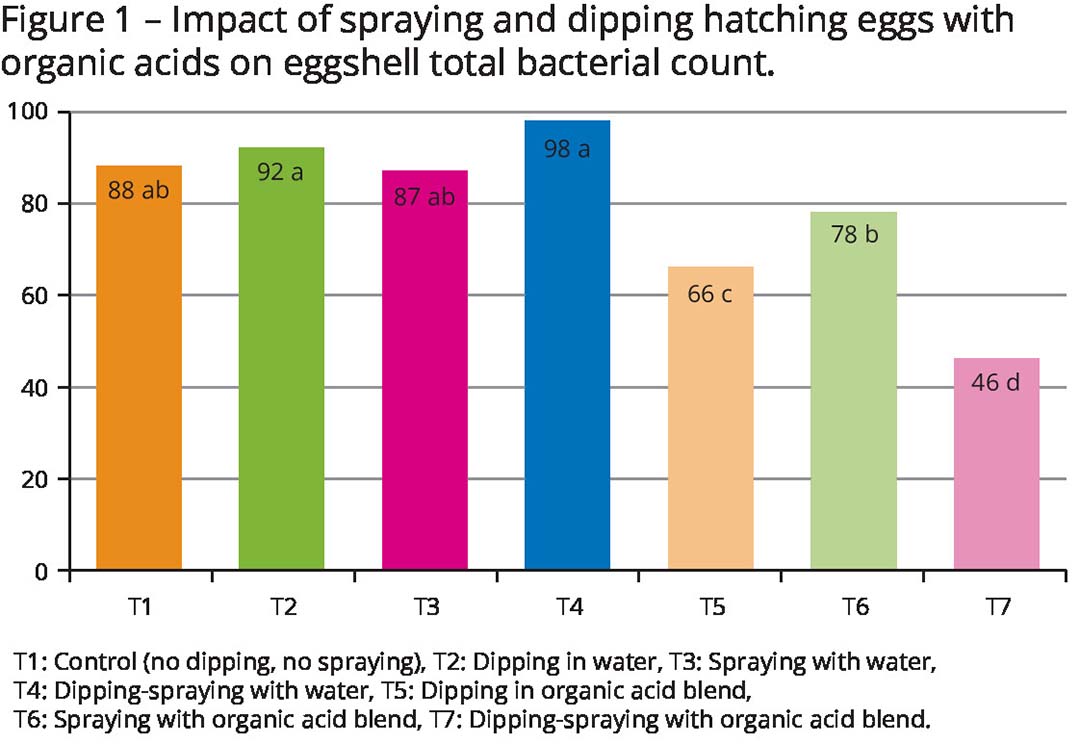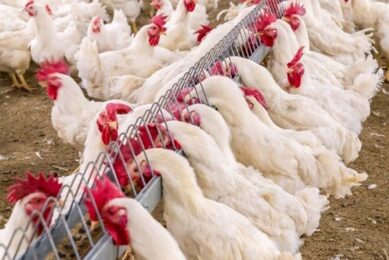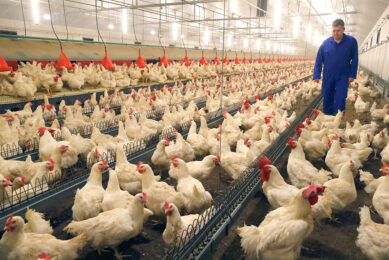Organic acids improve broiler breeder hatchability and chick quality

A recently published study shows how organic acids improve broiler breeders’ hatchability and chick quality by reducing embryonic mortality and total bacterial counts before hatch, while giving birds a better starting weight and immune response post hatch.
Hatchability – the percentage of eggs that hatch – is a trait of economic importance in the poultry industry; it depends on genetic and environmental factors. However, genetic analysis studies show that the trait of hatchability has low heritability. This gives more weight to the importance of environmental or management factors.
Besides influencing the physical characteristics of the egg and factors such as temperature, humidity and ventilation, research shows that the elimination or reduction of embryo contamination plays a key role in improving hatchability. Organic acids have a strong antimicrobial action against a wide range of pathogenic bacteria, making them potentially useful agents in reducing bacterial contamination of eggs.
When researchers from Atatürk University in Turkey, supplemented a Lohman laying hen diet with an organic acid mixture, the results showed significant improvements in performance, egg quality and intestinal histology. Studies in broilers showed that adding an organic acid blend (formic and propionic acids) to the diets of E. coli-challenged birds significantly improved growth performance, ileal morphology and immune responses, while reducing caecal E. coli.
In the present study researchers explored the effectiveness of dipping, spraying or dipping-spraying (dipping followed by spraying) of broiler breeder hatching eggs with organic acids on embryonic mortality, hatchability, chick quality, immunity and eggshell bacterial count.
Organic acid blend
To determine the synergetic effect of the organic acids, the researchers compared the effectiveness of dipping, spraying, or dipping-spraying of broiler breeder hatching eggs using a formic, propionic and lactic acid mixture. The blend consisted of 1 ml organic acids to 1000 ml of water. After dipping or spraying (at day 18 of incubation), the eggs were air dried before being transferred to the incubator for 3 days at (37.25°C) and 65% relative humidity until the end of 21 days of incubation. There were seven different dipping and spraying groups (Figure 1).
Embryonic mortality and hatchability
The results showed that embryonic mortality, which was measured at 15- 21 days and 1-21 days (Table 1), was significantly lower when an organic acid blend was used as a solution, compared to all the control groups. The reduction in embryonic mortality was attributed to the organic acids penetrating the eggshell and aiding the egg nutrient digestion process.
The results for both hatching of fertile eggs and hatching of total eggs were also significantly improved in all groups using organic acids compared to the control treatments, with the highest values observed when the organic acids were sprayed. It was noted that, as observed in similar previous studies, better hatching results were due to the combined effect of organic acid action on eggshell softness and the prevention of microbial build-up.
Chick quality traits
The post-hatch results of chick weight, chick length and shank length (Table 2) indicated that in all groups where organic acids were applied there was good chick development compared to chicks from untreated or water-treated eggs. The positive results on chick development with organic acid treatment was attributed to the effects of organic acids in lowering the microbial load inside the eggs.
Similarly, researchers from Adnan Menderes University, also in Turkey, investigated the influence of dietary organic acid blend supplementation on broilers with delayed feed access after hatch. They found that the organic acid blend improved growth performance and intestinal health to the same level as chicks that received feed immediately after hatching.
Immunity and eggshell bacterial count
To check how the organic acid blend enhanced immune response, the researchers measured the chicks’ antibody titre against Newcastle disease (ND) and infectious bronchitis (IB). The results showed that the blend had a positive effect on stimulating the chick’s immunity, as observed by significant increases in antibody titre against ND and IB in all three groups (dipping, spraying, and dipping-spraying) where organic acids had been applied, compared to the control groups. The highest chick antibody titre in the organic acid groups was observed by the spraying method, followed by dipping-spraying with the dipping method showing the least effect. However, all the organic acid application methods showed higher values compared to the water treatment groups.
 To assess the antibacterial properties of the organic acid blend using the different application methods, the researchers measured the total bacterial count (TBC) of eggshells (Figure 1). The group with the lowest TBC was treatment T7 (dipping-spraying) followed by T5 (dipping) and then T6 (spraying), with all the organic acid-treated eggs having the lowest bacterial counts compared to the control groups. “Organic acids have special antimicrobial properties that allow them to penetrate the cell membranes of pathogenic bacteria and lower the cell pH, resulting in the death of the bacteria,” they reported.
To assess the antibacterial properties of the organic acid blend using the different application methods, the researchers measured the total bacterial count (TBC) of eggshells (Figure 1). The group with the lowest TBC was treatment T7 (dipping-spraying) followed by T5 (dipping) and then T6 (spraying), with all the organic acid-treated eggs having the lowest bacterial counts compared to the control groups. “Organic acids have special antimicrobial properties that allow them to penetrate the cell membranes of pathogenic bacteria and lower the cell pH, resulting in the death of the bacteria,” they reported.
Positive effects
The researchers concluded their results indicate that using a synergetic blend of formic, propionic and lactic acid applied by a spraying in a concentration of 1 ml/litre of water significantly improves the hatchability, chick quality and immunity of broiler breeders to diseases such as Newcastle disease and infectious bronchitis. “Overall, our results show that organic acid blends can be used in addition to other means to increase the production and sustainability of a hatchery, by reducing embryonic mortality and bacterial contamination before hatch while giving birds a better starting weight and immune response after hatch.”
 Beheer
Beheer











 WP Admin
WP Admin  Bewerk bericht
Bewerk bericht